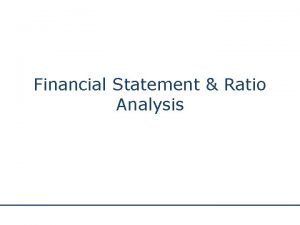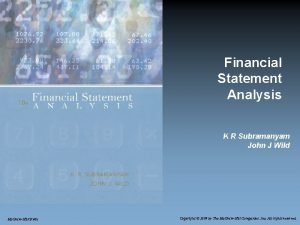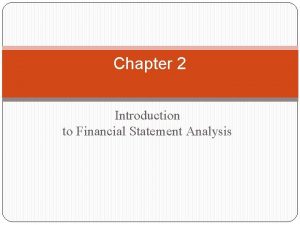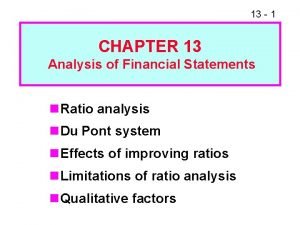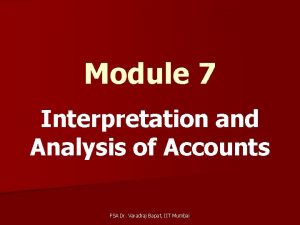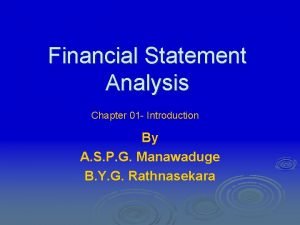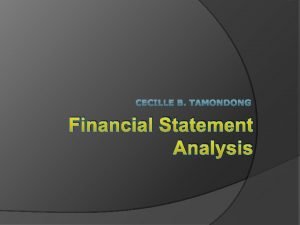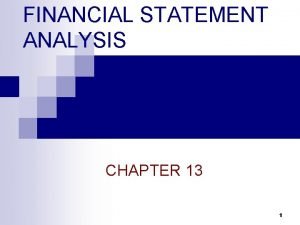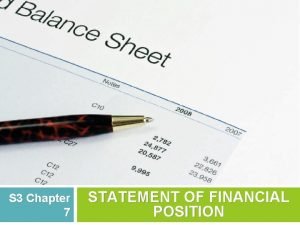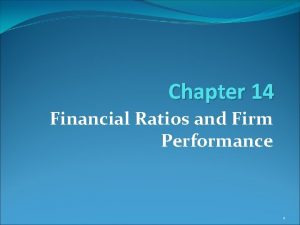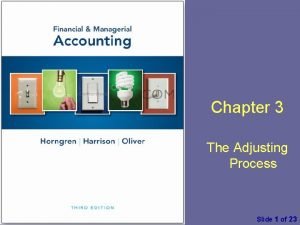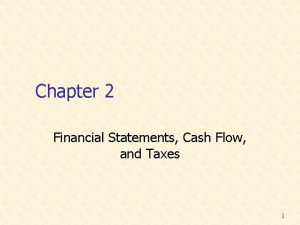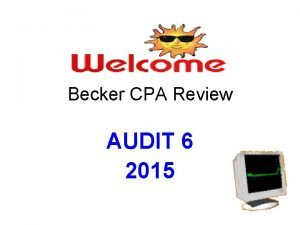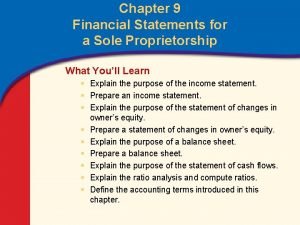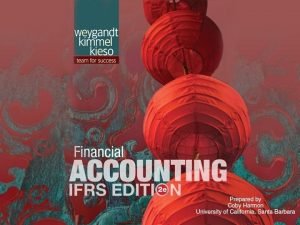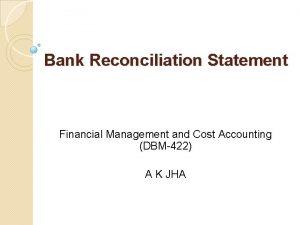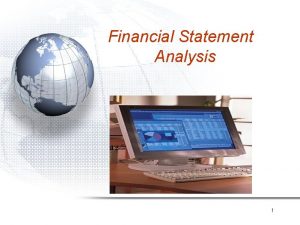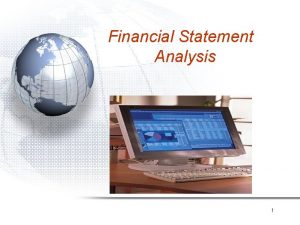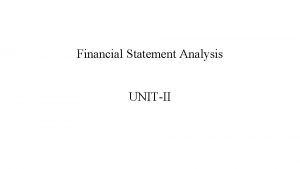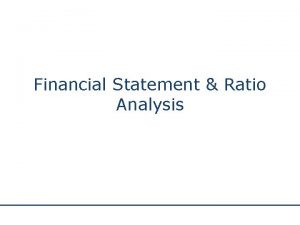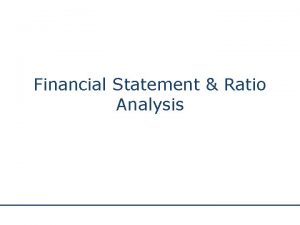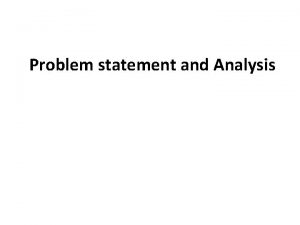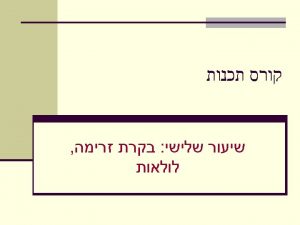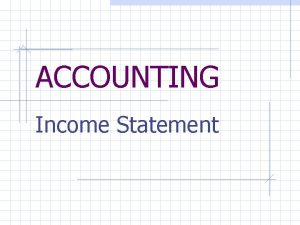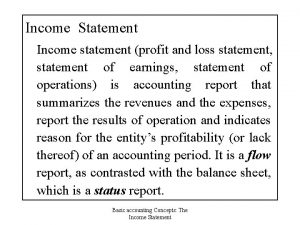Financial Statement Analysis Financial Statement Analysis Assessment of















































- Slides: 47

Financial Statement Analysis

Financial Statement Analysis • Assessment of the firm’s past, present and future financial conditions • Done to find firm’s financial strengths and weaknesses • Primary Tools: – Financial Statements – Comparison of financial ratios to past, industry, sector and all firms

Objectives of Ratio Analysis • Standardize financial information for comparisons • Evaluate current operations • Compare performance with past performance • Compare performance against other firms or industry standards • Study the efficiency of operations • Study the risk of operations

Uses for Ratio Analysis • • • Evaluate Bank Loan Applications Evaluate Customers’ Creditworthiness Assess Potential Merger Candidates Analyze Internal Management Control Analyze and Compare Investment Opportunities

Horizontal, Vertical, & Trend Analysis • Horizontal Analysis = calculating the Rupee change and % change in financial statement amounts across time • Vertical Analysis (Common Size Analysis) = changing all Rupee values for accounts to % values. • Trend Analysis = Using the “first” year as a base year, calculate future year Rupee values as a ratio.

Types of Ratios • Financial Ratios: – Liquidity Ratios • Assess ability to cover current obligations – Leverage Ratios • Assess ability to cover long term debt obligations • Operational Ratios: – Activity (Turnover) Ratios • Assess amount of activity relative to amount of resources used – Profitability Ratios • Assess profits relative to amount of resources used • Valuation Ratios: • Assess market price relative to assets or earnings

Liquidity Ratios • Current Ratio – Current Assets / Current Liabilities • Current Assets include Cash, Marketable Securities, Accounts Receivable and Inventory • Current Liabilities include Accounts Payable, Debt Due within one year, and Other Current Liabilities

Liquidity Ratios • Quick Ratio or Acid Test – Current Assets minus Inventory / Current Liabilities – A more precise measure of liquidity, especially if inventory is not easily converted into cash.

Liquidity Ratios • Cash Ratio

Liquidity Ratios • Interval Measure • Calculated to asses a firms ability to meet its regular cash outgoings

Leverage Ratios – Leverage ratios measure the extent to which a firm has been financed by debt. – Leverage ratios include: – Debt Ratio – Debt--Equity Ratio – Generally, the higher this ratio, the more risky a creditor will perceive its exposure in your business. Thus, high leverage ratios make it more difficult to obtain credit (loans).

Leverage Ratios Cont. § Leverage ratios also include the Interestcoverage Ratio, Fixed coverage Ratio etc, . § In contrast to the leverage ratios discussed on previous slide, the higher the Interest Coverage Ratio (Times-Interest-Earned Ratio), the more credit worthy the firm is, and the easier it will be to obtain credit (loans).

Total Debt Ratio – Proportion of interest bearing debt in the Capital structure. – In general, the lower the number, the better.

Debt-Equity Ratio – The Debt-Equity Ratio indicates the percentage of total funds provided by creditors versus by owners. – This ratio indicates the extent to which the business relies on debt financing (creditor money versus owner’s equity).

Interest Coverage Ratio – interest coverage ratio indicates the extent to which earnings can decline without the firm becoming unable to meet its annual interest costs. – Also called the Times-Interest-Earned Ratio, this calculation shows how many times the firm could pay back (or cover) its annual interest expenses out of earnings before interest and taxes (EBIT).

Interest Coverage Ratio DA = Depreciation and Amortization expenses

Fixed Coverage Ratio (OR) Debt Service Coverage Ratio (DSCR) – Principal repayments are added to interest payments •

Activity Ratios – Activity ratios measure how effectively a firm is using its resources, or how efficient a company is in its operations and use of assets. – In general, the higher the ratio, the better. – Activity ratios include: § Inventory turnover § Accounts receivable turnover § Average collection period. § Total assets turnover § Fixed assets turnover

Inventory Turnover Ratio – The inventory turnover ratio indicates how fast a firm is selling its inventories – This ratio indicates how well inventory is being managed, which is important because the more times inventory can be turned (i. e. , the higher the turnover rate) in a given operating cycle, the greater the profit.

Inventory Turnover Ratio Cont. – In the absence of information. Instead of CGS we can use Sales – In the case of CGS and Inventory both are valued at cost. While the sales are valued at market prices – Therefore better to use CGS

Accounts Receivable Turnover – The accounts receivable turnover ratio, indicates the average length of time it takes a firm to collect credit sales (in percentage terms), i. e. , how well accounts receivable are being collected. – If receivables are excessively slow in being converted to cash, liquidity could be severely impaired.

Average Collection Period – The average collection period is the average length of time (in days) it takes a firm to collect on credit sales.

Net Assets Turnover – The total assets turnover ratio, indicates how efficiently a firm is using all its assets to generate revenues. – This ratio helps to signal whether a firm is generating a sufficient volume of business for the size of its asset investment

Profitability Ratios – Profitability ratios measure management’s overall effectiveness as shown by returns generated on sales and investment. Profitability ratios include – Gross profit margin – Operating profit margin – Net profit margin – Return on total assets (ROA) – Return on stockholders’ equity (ROE)

Gross Profit Margin – The gross profit margin is the total margin available to cover operating expenses and yield a profit. This ratio indicates how efficiently a business is using its labor and materials in the production process, and shows the percentage of net sales remaining after subtracting cost of goods sold. – The higher the ratio, the better. A high gross profit margin indicates that a firm can make a reasonable profit on sales, as long as it keeps overhead costs under control.

Operating Profit Margin – The Operating Profit Margin measures profitability without concern for taxes and interest. – The higher the ratio, the better. A high operating profit margin indicates that a firm can make a reasonable profit on sales, as long as it does good tax planning.

Net Profit Margin – The net profit margin shows the after-tax profits per rupee of sales. – The higher the ratio, the better.

Return on Investment (ROI) OR Return on Capital Employed (ROCE) – The return on total assets ratio shows the after-tax profits per dollar of assets; this is also called return on investment (ROI). – The ROI is perhaps the most important ratio of all. It is the percentage of return on money invested in the business. The ROI should always be higher than the rate of return on an alternative, risk-free investment. – The higher the ratio, the better.

Return on Shareholders’ Equity – The net profit margin shows the after-tax profits per rupee of sales. – The higher the ratio, the better.

Market Valuation Ratios – Earnings per share (EPS) – Price-earnings ratio (P/E). – Dividend Yield – Market to Book Ratio

Earnings Per Share (EPS) – The Profitability of the common shareholders’ Investment. – The higher the ratio, the better. – Adjust for the bonus issues

Dividends Per Share (DPS) – Earnings distributed to the shareholders’ as cash dividends. – The higher the ratio, the better. –.

Dividend Payout Ratio & Retention Ratio = 1 - Payout Ratio Growth in Equity = Retention Ratio * ROE

Market Valuation Measures • Dividend Yield – Dividend / Market Value per Share • payout declared as a percentage of the stock price • Earnings Yield – EPS / Market Value per Share – Dividend and Earnings yield evaluate the shareholders’ return in relation to the market value of the share

Price-Earnings Ratio – Measure of optimism or pessimism about firm’s future. – High PE Ratio indicates optimism – Low PE Ratio indicates pessimism

• Market Value to Book Value Ratio – Stock price / book value per share • The number of times the market values the stock over its paid-in capital and retained earnings.

Ratio Analysis Limitations • Financial ratios are based on accounting data, and firms differ in their treatment of such items as depreciation, inventory valuation, research and development expenditures, pension plan costs, mergers, and taxes. • Reflects Book Value • Does not take size differences of companies into account • Identifies problem areas, but not causes

Limitations § § Seasonal factors can influence comparative ratios. A firm’s financial condition depends not only on the functions of finance, but also on many other factors such as § Management, marketing, production/operations, R&D, and MIS decisions § Actions by competitors, suppliers, distributors, creditors, customers, and shareholders § Economic, social, cultural, demographics, environmental, political, governmental, legal, and technological trends.

Cautions in using Ratio Analysis • • • Company differences Price Level Different Definitions Changing Situations Past Data

Dupont Analysis • ROE is a closely watched number • It is a strong measure of how well the management of a company creates value for its shareholders • The number can be misleading • Due to its vulnerability to measures that increase its value while making the stock risky • Without a way of breaking down the components of ROE, investors could be duped into believing a company is a good investment when it is not.

The Du. Pont System • Method to breakdown ROE into: – ROI and Equity Multiplier • ROI is further broken down as: – Profit Margin and Asset Turnover • Helps to identify sources of strength and weakness in current performance • Helps to focus attention on value drivers

Components of ROE • ROE = (Net profit margin) * (Asset Turnover) * (Equity multiplier) • Operating Efficiency - Profit margin • Asset use efficiency – Total asset turnover • Financial leverage – Equity multiplier

Dupont Calculation • ROE =

The Du. Pont System ROE ROI Profit Margin Equity Multiplier Total Asset Turnover

The Du. Pont System ROE ROA Profit Margin Equity Multiplier Total Asset Turnover

The Du. Pont System ROE ROA Profit Margin Equity Multiplier Total Asset Turnover

The Du. Pont System ROE ROA Profit Margin Equity Multiplier Total Asset Turnover
 Financial analysis assessment
Financial analysis assessment Chapter 14 financial statement analysis solutions
Chapter 14 financial statement analysis solutions Subramanyam financial statement analysis
Subramanyam financial statement analysis Chapter 14 financial statement analysis solutions
Chapter 14 financial statement analysis solutions Financial statement analysis framework
Financial statement analysis framework Chapter 2 financial statement analysis solutions
Chapter 2 financial statement analysis solutions Financial statement analysis objectives
Financial statement analysis objectives Chapter 13 financial statement analysis
Chapter 13 financial statement analysis Vertical analysis interpretation
Vertical analysis interpretation Introduction of financial statement analysis
Introduction of financial statement analysis Financial analysis of banks
Financial analysis of banks Solvency investopedia
Solvency investopedia Chapter 13 financial statement analysis
Chapter 13 financial statement analysis Limitations of financial statement analysis
Limitations of financial statement analysis Chapter 1 overview of financial statement analysis
Chapter 1 overview of financial statement analysis Financial statement analysis and planning
Financial statement analysis and planning Chapter 14 financial statement analysis
Chapter 14 financial statement analysis Characteristics of portfolio assessment
Characteristics of portfolio assessment Static assessment vs dynamic assessment
Static assessment vs dynamic assessment Portfolio assessment matches assessment to teaching
Portfolio assessment matches assessment to teaching Financial method of motivation
Financial method of motivation Statement validity analysis
Statement validity analysis Tori's statement of financial position
Tori's statement of financial position Cash debt coverage
Cash debt coverage Financial statement purpose
Financial statement purpose Financial statement robert kiyosaki
Financial statement robert kiyosaki Parents' financial statement sample
Parents' financial statement sample Nature of financial statement
Nature of financial statement Income statement in financial accounting
Income statement in financial accounting Financial statement in millions
Financial statement in millions Becker and smith cpas performs a financial statement
Becker and smith cpas performs a financial statement In-house financial statement
In-house financial statement Report form statement of financial position
Report form statement of financial position Operating statement
Operating statement Statement of financial position assets
Statement of financial position assets No disclosures
No disclosures Chapter 9 financial statements for a sole proprietorship
Chapter 9 financial statements for a sole proprietorship Accounting for merchandising business ppt
Accounting for merchandising business ppt Parent financial statement
Parent financial statement Classified statement of financial position
Classified statement of financial position Financial statement comparability
Financial statement comparability Foreign currency translation example
Foreign currency translation example Reconciliation in accounting meaning
Reconciliation in accounting meaning Structure of financial statement
Structure of financial statement Financial position account form
Financial position account form Financial statement red flags
Financial statement red flags Personal statement of financial position
Personal statement of financial position Parents financial statement
Parents financial statement
